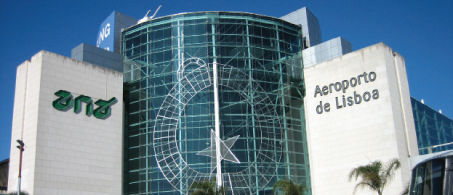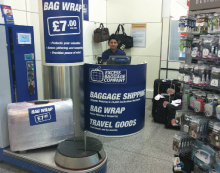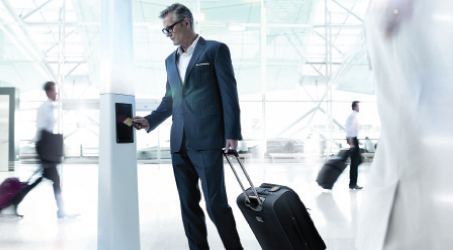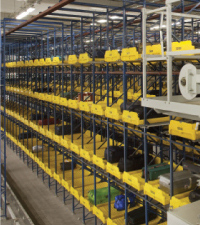
Since December 2008, Lisbon Airport has been sorting transfer baggage solely by RFID.
The true cost of mishandled baggage is best highlighted by the conclusion of the SITA Baggage Report 2010. While figures for 2009 showed that the mishandled bag rate had dropped by 24% year-on-year, 25 million bags were still mishandled globally, resulting in a cost of $2.5 billion (€1.8 billion) to the industry.
As airlines and airports alike have explored how to overcome this issue, the reliability of bar coded bag tags, which offer an average read-rate of approximately 80%, has been highlighted and new technology, namely Radio Frequency Identification (RFID), has been identified as a more dependable alternative. Ranging from Las Vegas McCarran to Aalborg, RFID has been adopted by a handful of airports and while this has required the upgrade of the necessary infrastructure, the result has been a read-rate in excess of 99%.
Aalborg Airport last year adopted Lyngsoe Systems’ RFID on Baggage solution, following in the footsteps of Lisbon, Milan Malpensa and Hong Kong International airports. “We needed a new solution that could help us handle an extensive increase in the volume of baggage,” said Søren Svendsen, CEO, Aalborg Airport.
“RFID is the future for baggage handling and will be able to provide us with new possibilities for accurate baggage handling and passenger services that we could not provide without it. Therefore, Lyngsoe’s RFID solution will be the platform for a completely new way of providing passenger services, RFID technology is supported by IATA (International Air Transport Association), which is very important for us and the industry.”
The upgrade required the installation of new RFID readers, while the facilities had to be in place for the printing of the new tags. As the passengers’ end destination may not utilise RFID technology, traditional bar coded bag tags must also be printed. While all of this accrues additional cost, Svendsen outlined that the airport was keen to take responsibility for the project.
He said: “The main cost for this was covered by the airport but the main benefit is for the airline. This is one of the main discussion points when you consider adopting RFID tagging but, for us, we take responsibility and ownership of all passengers who use Aalborg Airport.”
Lisbon Airport, which adopted RFID-only baggage handling for transfer passengers in 2008, also covered the entire cost of the implementation of the next-generation baggage handling system in the then-new transfer terminal. Since it’s installation, the system has recorded near-perfect results, with operating costs reportedly similar to that of the traditional baggage handling systems.
“Airports and airlines can improve significantly by changing old barcode technology to RFID technology in existing baggage handling systems,” explained Lyngsoe Systems’ Jan Poulsen. “The manual encoding process will be minimised due to the significantly higher read-rate on baggage tags with RFID than traditional baggage tags without RFID, and that leads to more efficient use of the theoretical capacity in a baggage handling system.”
Excess opens LGW BAGGAGE CENTRE

Excess opened its first ‘pop-up’ Baggage Centre at Gatwick’s South Terminal in February.
Excess opened its first ‘pop-up’ Baggage Centre at Gatwick’s South Terminal in February. The concept allows speedy installation or, if necessary, quick relocation of an outlet, and also has the advantage of significantly reducing development costs. The outlet, which is positioned adjacent to busy check-in areas, catering for Virgin and easyJet passengers, provides Luggage Shipping, Bag Wrap, and Travel Goods Retail, and complements the company’s three other outlets in the terminal.
David Elliott, Excess Baggage Company’s CEO, commented: “This outlet has generated a significant amount of interest from airport operators both in the UK, and further afield in Europe and Asia. Putting a Baggage Shipping service in front of passengers as they check-in has significantly increased our visibility, and usage, and the unit is exceeding all expectations in terms of turnover. We are doing record volumes of Bag Wrapping, and Travel Goods are simply flying out of the door.”
He continued: “We hope that this unit’s success will convince other airport terminal operators of the validity and viability of this offer. Of course, we do encourage airports to cherry pick the services that they want to have in a particular location, and we have limited this outlet to three services only, as we have further units in the vicinity, providing Over-the-Counter Left Luggage, Duty Free Shop & Collect, and Online Lost Property. We are currently in discussions with a number of airports and we are keen to roll out the concept as widely as possible'”
Elliott also noted: “Our online Travel Goods website, www.LuggageExpress.co.uk, is also attracting wide interest. This site allows terminal operators, airlines, and travel vendors to generate an extra revenue stream from passengers pre-travel.”

Qantas is currently rolling out the RFID-enabled Q Bag Tag as part of the Next Generation Check-in programme.
Q Bag Tag
As part of Qantas’ Next Generation Check-In programme – which provides passengers with a variety of self-service options – the RFID Q Bag Tag is currently being rolled out. The reusable tag removes the need for passengers to print and attach temporary tags for every journey and they can currently be used in Perth T2, Sydney T3 and Melbourne T1 domestic terminals, while it will be rolled out on a widespread basis across Australia throughout this year.
However, as opposed to the Aalborg and Lisbon airport instances, in this case it is the airline which has taken responsibility for the installation of the equipment. At Sydney Airport, for instance, RFID tunnels have been installed to ensure the smooth delivery of the bags through the existing system, while Qantas has installed Auto Bag Drops, newly designed check-in counters, four zones of self-service kiosks and customer service points.
As the information on each tag is synchronised with the passenger’s boarding card or Qantas Card information, Q Card readers have also been installed, along with baggage repack areas and weighing scales. While the infrastructure upgrade has been significant, it has been carried out at no cost to the airport itself.
Although the uptake of next-generation bag tags has been relatively slow, as RFID continues to prove its worth as a long-term, financially viable investment, an increasing number of airports and airlines may well be convinced to further explore next-generation bag tags as a solution to the problem of the lost bag.
Vanderlande’s Smart baggage handling

The Vanderlande BAGSTORE, based on crane/racking technology, provides high storage density, 100% availability and fast, individual access.
What challenges are shaping today’s baggage handling strategies? Top of the list, of course, is cost control. But airports are also faced with growing passenger numbers, higher peaks and more self-service. In many regions staff are hard to find and retain for what are often heavy manual tasks. Available space for growth is often limited.
It’s clear that effective and reliable IT is a key factor in meeting these challenges. Smart controls and automated handling enable efficiency, speed and reliability of operations to be optimised. This results in cost savings, reduced manual labour requirements and improved working conditions.
Baggage handling is changing to a controlled, demand-driven process, in which bags are managed dynamically and on-demand, as required for flight building.
Baggage flows are not stable and are subject to peaks at busy times. Scaling systems and manpower for peak demand is clearly wasteful for resources. By disconnecting demand and supply using buffers, make-up peaks can be shaved and tailored to available resources, creating a more constant, controlled flow to the make-up positions.
The on-demand flight make-up process depends on automated, intelligent bag storage. This allows make-up opening times to be shortened, labour requirements to be reduced, and higher volumes to be handled within existing space constraints. The Vanderlande BAGSTORE, based on crane/racking technology, provides high storage density, 100% availability and fast, individual access. Furthermore, a bag store increases passenger satisfaction by longer check-in opening times.
Working conditions are greatly improved by introducing make-up on demand in combination with automated loading. With the Vanderlande BAGLOAD concept, delivered in partnership with Grenzebach Automation, handlers no longer need to do the heavy part of manual loading of bags into carts or containers. This reduces risks of injuries caused by conventional heavy, stressful manual handling.







